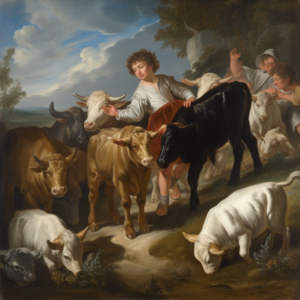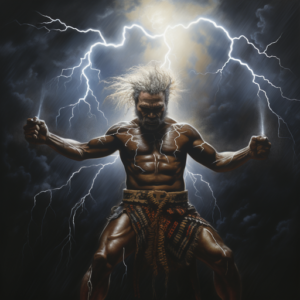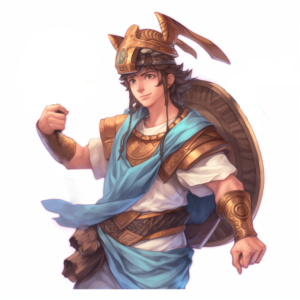Mercury is the messenger to the Roman gods. He is well known for his incredible speed. Originally, Mercury was a god of trade related to the corn crop. In fact, his name is derived from the Latin word merces, meaning “merchandise.”
Mercury, who is sometimes referred to as Mercurius, was also lauded as the protector of merchants, travelers, and shopkeepers. He was also defamed as the patron of thieves and those who played practical jokes.
Origins
In early Roman mythology, there was no mention of Mercury as a member of the ruling class of gods. Eventually, he was absorbed into Roman culture from the Greek god Hermes, messenger of the Greek gods. Mercury carried out many of the same functions as Hermes.
Mercury was the son of Jupiter, the Roman equivalent of the Greek god Zeus. The story of the birth of Mercury held that Jupiter secretly impregnated the goddess Maia in a cave on the island of Arcadia. The following day, Maia gave birth to Mercury before wrapping him in swaddling blankets and falling asleep. As his mother slept, Mercury raced across Arcadia to steal cattle from his brother, Apollo, before returning to his mother.
Maia woke to the sight of Mercury wrapped in his swaddling blanket and Apollo accusing him of stealing his cattle. Eventually, Jupiter stepped in to reveal he had watched Mercury steal the cattle and ordered their return. During the night, Mercury had fashioned a lyre from cattle intestines and began playing beautiful music. This inspired Apollo to ask for a trade of the cattle for the lyre.

Appearance
In most portrayals, Mercury is shown as a youthful god of Rome who is clean-shaven and is often little more than a child. Mercury is depicted in Roman artworks as wearing a helmet and sandals with attached wings that reflect his speed and position as the messenger of the gods. The son of Jupiter is also the god of commerce, leading him to being shown in some sculptures and paintings holding a purse.
Symbols
There are many symbols associated with Mercury, including his winged cap and sandals that reflect the speed of the Roman god. Mercury is often depicted as carrying a staff, which was a symbol the members of his cult added to their daily lives.
Mercury is associated with many animals, including the tortoise that played a role in his first day of life. Mercury used the shell of a tortoise to fashion the lyre he would trade for the cattle of Apollo. The tortoise would become a common symbol of Mercury throughout Roman culture and be accompanied by his close links to the ram and the rooster.
The rooster is the symbol of the new day that is brought by Mercury as a messenger of the gods. The ram is a symbol of fertility for the Roman people and is often seen with Mercury in stories and artworks.
Powers & Duties
Mercury’s main power is his ability to move at great speeds. He is most well-known for his role as a messenger to the gods. Interestingly, the role of the messenger also included the task of conducting the passage of individuals from Rome to the underworld when they died.
Mercury is also one of the most duplicitous gods in Roman culture. He is known for his trickery and ability to cheat people out of their belongings.
Myths & Stories
Mercury plays a role in many myths. As noted above, he is said to have stolen cattle and a bow and arrow when just a child. In the myth of Cupid and Psyche, he is called upon by Jupiter to make a proclamation demanding the capture of Psyche.
In the Aeneid, he is sent by Jupiter to Aeneas with orders to leave his lover and “sail away to fulfill his destiny in Italy.” He also plays a role in Roman poetry and theater, much of which was based on mythology.
In the play Amphitruo by the dramatist Plautus, Mercury dresses as a servant and aids Jupiter in disguing himself Amphitryon in order to seduce Amphitryon’s wife.
The poet Horace wrote of him in his Odes. In fact, Horace called himself mercurialis, meaning a lyric poet protected by Mercury.
Many of the myths of Mercury are derived from those of Hermes. Monuments to Hermes were thought to bring good luck, and this idea was perpetuated with Mercury as well. Another borrowed role was that of escorting the souls of the deceased to the underworld. It is speculated that the myths originated among shepherds, lending their interest in “music and fertility.” In fact, in some legends, Mercury is said to have invented the guitar-like lyre, and his son is said to have been a nymph who invented the music of the pastoral societies.
Worship
A temple to Mercury was dedicated on Rome’s Aventine Hill in 495 B.C. The festival of Mercuralia was held on May 15, the anniversary of the temple dedication, in honor of both Mercury and his mother Maia of the Pleiades. Rituals of this festival involved merchants drawing water from the well at Porta Capena to be sprinkled on their trade goods and on their own heads. Trade fairs were also held at the temple, and it was the location of Rome’s busy commercial center.
Art
In art and statues, Mercury is typically depicted as a handsome young man, even boyish in appearance, wearing a white garment. Mercury often carries a money purse, symbolizing his function as patron of merchants and business owners. His fleetness as messenger of the gods is represented by a hat or sandals with wings, called petasus and talaria, respectively. Mercury was thus called Alipes, meaning “with the winged feet.” He is also seen carrying a staff called a caduceus. The caduceus was a symbol of peace, carried by ambassadors to foreign lands. It consisted of a branch with two shoots, originally decorated with ribbons or garlands. In later times, these attributes were replaced by two twining snakes, with a pair of wings above the snakes. The snakes were related to Mercury’s role as a fertility god and in delivering souls to the underworld. Today, this symbol is used to represent physicians, the medical field, and the U.S. Army Medical Corps.
Today
Like many mythical figures, Mercury has been immortalized in the naming of celestial objects. The planet Mercury, as visible just after sunset, was called in ancient times by his Greek counterpart, Hermes. This was likely due to the planet’s rapid motion in comparison to other stellar objects. Interestingly, Mercury’s morning visitation, just before sunrise, was not recognized as being the same “star;” it was thus called Apollos. The element mercury (Hg) , atomic number 80 on the periodic table, was once known as “quicksilver.” The symbol for the planet Mercury was used to represent quicksilver in sixth century alchemy, and thus the chemical took on the name of the god as well.
Facts about Mercury
- Hermes is the Greek equivalent of the Roman god Mercury.
- He was the grandson of the Titan Atlas.
- Woden / Odin was significantly affiliated with Mercury in ancient times. They were referenced together in the Roman author Tacitus’ literary work Germania. Germanic tribes referred to Wednesday as Wodenstag, whereas in Latin Wednesday is called dies Mercurii. This was possibly due to their similar roles in sacrifice and death.
- Gaulish Mercury refers to worship of Mercury by the early Celtic tribes of western Europe. In these tribes, he was likely held as the highest among the gods.
- The French translation of Wednesday is Mercredi. In Italian it is Mercoledì. Both are derived from the Latin word for Mercury.
- Mercury is the closest planet to the Sun. It is the fastest planet to complete a full orbit around the Sun.
- The element Mercury is named after the Roman god.
- Mercury was a brand of automobile whose production lasted for 70 years. Production of the cars ceased in 1970.
- Mercury’s roles included being the god of store owners, merchants, travelers, trade, profit, tricksters, and theives.
*As an Amazon Associate I earn from qualifying purchases.






